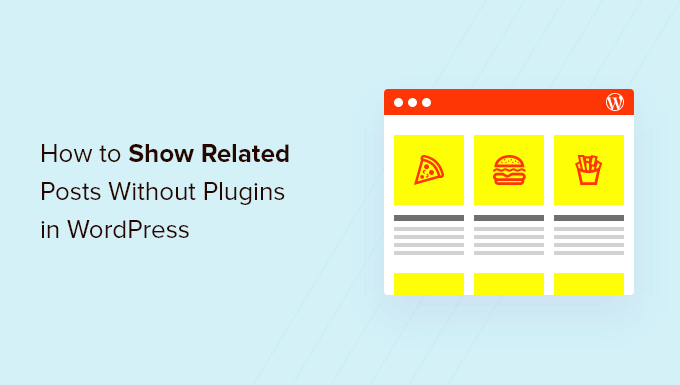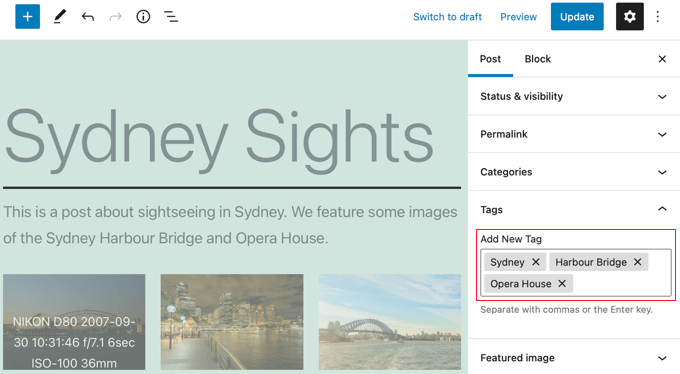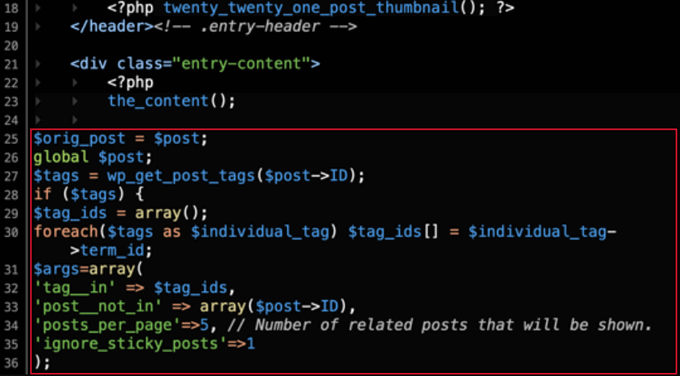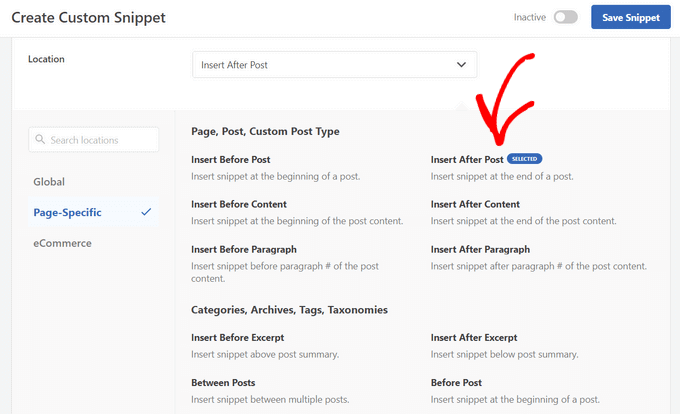Möchten Sie eine Liste verwandter Beiträge auf Ihrer WordPress-Website anzeigen und lieber Code als ein Plugin verwenden?
Bei WPBeginner betonen wir oft, wie wichtig es ist, Ihr Publikum zu fesseln und es dazu zu bringen, Ihre Inhalte zu erkunden. Eine effektive Strategie, die wir auf unzähligen erfolgreichen WordPress-Websites gesehen haben, ist die Anzeige von verwandten Beiträgen.
Wenn die Besucher Ihres Blogs einen Artikel, der sie interessiert, zu Ende gelesen haben, können Sie ihnen eine Liste mit verwandten Beiträgen anbieten, um sie bei der Stange zu halten und ihnen zu helfen, neue Inhalte zu lesen.
In diesem Artikel zeigen wir Ihnen, wie Sie mit WordPress verwandte Beiträge mit Code anzeigen können, ohne dass ein Plugin erforderlich ist.

Warum verwandte Beiträge in WordPress anzeigen?
Wenn Ihr WordPress-Blog zu wachsen beginnt, kann es für die Benutzer schwieriger werden, andere Beiträge zum selben Thema zu finden.
Die Anzeige einer Liste verwandter Inhalte am Ende jedes Blogbeitrags ist eine gute Möglichkeit, Ihre Besucher auf Ihrer Website zu halten und die Seitenaufrufe zu erhöhen. Es hilft auch, die Sichtbarkeit Ihrer wichtigsten Seiten zu verbessern, indem Ihre besten Inhalte dort angezeigt werden, wo die Besucher sie leicht finden können.
Wenn Sie mit Code nicht vertraut sind, ist es einfacher, eines der vielen WordPress-Plugins für verwandte Beiträge zu wählen, die verwandte Beiträge ohne Code anzeigen können.
Wenn Sie sich aber schon immer gefragt haben, ob Sie verwandte Beiträge auch ohne Plugins anzeigen können, stellen wir Ihnen zwei verschiedene Algorithmen vor, mit denen Sie verwandte Beiträge mit Vorschaubildern allein mit Hilfe des Codes erzeugen können:
Hinweis: Wenn Sie zu jedem verwandten Beitrag ein Thumbnail anzeigen möchten, müssen Sie diesen Beiträgen zunächst ein Bild hinzufügen.
Methode 1: Wie man verwandte Beiträge in WordPress nach Tags anzeigt
Eine effiziente Möglichkeit, verwandte Inhalte zu finden, besteht darin, nach anderen Beiträgen zu suchen, die dieselben Tags aufweisen. Tags werden oft verwendet, um sich auf die spezifischen Details in einem Beitrag zu konzentrieren.
Daher sollten Sie den Beiträgen, die Sie miteinander in Verbindung bringen möchten, einige gemeinsame Tags hinzufügen. Sie können sie in das Feld “Tags” im WordPress-Editor eingeben.

Nachdem Sie Schlagwörter zu Ihren Beiträgen hinzugefügt haben, müssen Sie als Nächstes das folgende Code-Snippet in das Template single.php Ihres Themes einfügen.
Wenn Sie Hilfe beim Hinzufügen von Code zu Ihrer Website benötigen, lesen Sie unsere Anleitung zum Einfügen von Snippets aus dem Internet in WordPress.
1 2 3 4 5 6 7 8 9 10 11 12 13 14 15 16 17 18 19 20 21 22 23 24 25 26 27 28 29 30 31 32 | $orig_post = $post;global $post;$tags = wp_get_post_tags($post->ID);if ($tags) {$tag_ids = array();foreach($tags as $individual_tag) $tag_ids[] = $individual_tag->term_id;$args=array('tag__in' => $tag_ids,'post__not_in' => array($post->ID),'posts_per_page'=>5, // Number of related posts that will be shown.'ignore_sticky_posts'=>1);$my_query = new wp_query( $args );if( $my_query->have_posts() ) { echo '<div id="relatedposts"><h3>Related Posts</h3><ul>'; while( $my_query->have_posts() ) {$my_query->the_post(); ?> <li><div class="relatedthumb"><a href="<?php the_permalink()?>" rel="bookmark" title="<?php the_title(); ?>"><!--?php the_post_thumbnail(); ?--></a></div><div class="relatedcontent"><h3><a href="<?php the_permalink()?>" rel="bookmark" title="<?php the_title(); ?>"><!--?php the_title(); ?--></a></h3><!--?php the_time('M j, Y') ?--></div></li><!--?php }echo '</ul--></ul></div>';}}$post = $orig_post;wp_reset_query(); |
Dieser Code sucht nach Tags, die mit einer Seite verbunden sind, und führt dann eine Datenbankabfrage aus, um Seiten mit ähnlichen Tags zu finden.
Wo sollten Sie den Code platzieren? Das hängt von Ihrem Theme ab, aber in den meisten Fällen sollten Sie den Code in die Vorlage single.php Ihres Themes nach dem Hauptbeitrag und direkt über dem Kommentarbereich einfügen können.
Wenn Sie das Twenty Twenty-One-Theme verwenden, wie wir es auf unserer Demoseite tun, dann ist ein guter Ort, um den Code in die Datei template-parts/content/content-single.php nach dem Header und direkt nach <?php the_content(); einzufügen.

Dadurch werden verwandte Inhalte automatisch in jedem WordPress-Beitrag angezeigt. Sie müssen das Styling und das Aussehen Ihrer verwandten Beiträge ändern, um sie an Ihr Theme anzupassen, indem Sie benutzerdefiniertes CSS hinzufügen.

Tipp: Anstatt die Dateien Ihres Themes zu bearbeiten, was Ihre Website zerstören könnte, empfehlen wir die Verwendung eines Code-Snippets-Plugins wie WPCode.
WPCode macht es sicher und einfach, benutzerdefinierten Code in WordPress hinzuzufügen. Außerdem bietet es “Einfügeoptionen”, mit denen Sie automatisch Snippets an bestimmten Stellen Ihrer WordPress-Website einfügen und ausführen können, z. B. nach einem Beitrag.

Weitere Details finden Sie in unserem Leitfaden zum Hinzufügen von benutzerdefiniertem Code in WordPress. Sie können auch unseren ausführlichen WPCode-Test lesen, um mehr über das Plugin zu erfahren.
Methode 2: Verwandte Beiträge in WordPress nach Kategorie anzeigen
Eine weitere Möglichkeit, verwandte Inhalte anzuzeigen, ist die Auflistung von Beiträgen, die sich in derselben Kategorie befinden. Der Vorteil dieser Methode ist, dass die Liste der verwandten Beiträge fast nie leer ist.
Wie bei Methode 1 müssen Sie einen Code-Snippet in die Vorlage single.php Ihres Themes oder in ein Code-Snippets-Plugin wie WPCode einfügen. Weitere Einzelheiten finden Sie unter Methode 1 und in unserer Anleitung zum Hinzufügen von benutzerdefiniertem Code in WordPress.
1 2 3 4 5 6 7 8 9 10 11 12 13 14 15 16 17 18 19 20 21 22 23 24 25 26 27 28 29 30 | $orig_post = $post;global $post;$categories = get_the_category($post->ID);if ($categories) {$category_ids = array();foreach($categories as $individual_category) $category_ids[] = $individual_category->term_id;$args=array('category__in' => $category_ids,'post__not_in' => array($post->ID),'posts_per_page'=> 2, // Number of related posts that will be shown.'ignore_sticky_posts'=>1);$my_query = new wp_query( $args );if( $my_query->have_posts() ) {echo '<div id="related_posts"><h3>Related Posts</h3><ul>';while( $my_query->have_posts() ) {$my_query->the_post();?> <li><div class="relatedthumb"><a href="<?php the_permalink()?>" rel="bookmark" title="<?php the_title(); ?>"><!--?php the_post_thumbnail(); ?--></a></div><div class="relatedcontent"><h3><a href="<?php the_permalink()?>" rel="bookmark" title="<?php the_title(); ?>"><!--?php the_title(); ?--></a></h3><!--?php the_time('M j, Y') ?--></div></li><!--?php }echo '</ul--></ul></div>';}}$post = $orig_post;wp_reset_query(); |
Jetzt sehen Sie eine Liste mit verwandten Inhalten am Ende jedes Beitrags.
Wenn Sie die Gestaltung und das Erscheinungsbild Ihrer verwandten Seiten ändern möchten, müssen Sie benutzerdefinierte CSS hinzufügen, die zu Ihrem Thema passen.
Expertenanleitungen zu verwandten Beiträgen in WordPress
Möchten Sie mehr über die Anzeige von verwandten Beiträgen in WordPress erfahren? Sehen Sie sich diese hilfreichen Tutorials zu verwandten Beiträgen an:
- Wie man verwandte Beiträge in WordPress anzeigt (Schritt für Schritt)
- Wie man verwandte Beiträge desselben Autors in WordPress anzeigt
- Hinzufügen von Inline Related Posts in WordPress Blog Beiträgen
- Wie man zufällige Beiträge in WordPress anzeigt
- Wie man verwandte Seiten in WordPress anzeigt
Wir hoffen, dass dieses Tutorial Ihnen geholfen hat zu lernen, wie man verwandte Beiträge mit Miniaturansichten in WordPress ohne Plugins anzeigt. Vielleicht möchten Sie auch erfahren, wie Sie die Besucher Ihrer WordPress-Website verfolgen können, oder unsere Liste mit 24 Tipps zur Beschleunigung Ihrer Website lesen.
Wenn Ihnen dieser Artikel gefallen hat, dann abonnieren Sie bitte unseren YouTube-Kanal für WordPress-Videotutorials. Sie können uns auch auf Twitter und Facebook finden.





imranhunzai
Absolutely awesome! and yeah it helps.
8MEDIA
amazing post ,, thanks
shaileshtr
It is good to show related post in wordpress blog without plugiN. iIt will consume less bandwidth and time to load. http://shareitto.com Thanks for your suggestion.
zioneyemedia
I do have a question on this: I’m wrestling on the code to capture posts from child categories versus parent categories. Any advice?
AmandaLong
This rocks … Thanks!
dustinporchia
I’m trying to use the related posts by category and I noticed that you said the code has to come before the comments in the main loop. In my code I want the related posts to come after the comments in the loop. When I do this I notice my disqus comment plugin takes longer to load now. Is that because of an error with the comments or is that normal?
dustinporchia
Nevermind…I just switched to livefyre as this is more of what I’m looking for in a comment system anyways…thanks!
subzerokh
please
could someone help a newbie like me customize this script so it’ll display related post in an horizontal way?
from left to right..
instead of currently showing it from up to down, vertically…
zioneyemedia
Hey,
How I did it is I replaced the and codes with my own html and css. The codes create lists for each post, and that is usually in a vertical fashion.
——————
<a href="” rel=”bookmark” title=””> <a href="” rel=”bookmark” title=””>
——————
I replaced the opening with and replaced the closing with as my html tags. Then I write my CSS to fit that specific div class needs on your website. For example, a sample pleft class could look like this:
.pleft {float:left; padding:2px; margin:10px; width:278px; height:190px;}
I use the float: selector on my CSS to move posts horizontally, and the margins and padding to give each post spacing within each other. I added in a specific width and height for additional examples.
Hope this helps.
Simos
@zioneyemedia thank you!
gcog
I’ve got related tags for sure, but when I add the code I see nothing. Also, when I add your code to restrict to a custom post type, it gives me an error. I did change the post type to my specific post type.
subzerokh
@wpbeginner hello
thanks for your quick answer…
but i’m a real novice at all you are saying..
can you please give a litlle exemple?
for making them horizontal as on your own blog?
can get in touch by my mail: khiloc at gmail dot com
wpbeginner
@subzerokh You would have to edit the styling. It is not that hard. Simply wrap each post in a div. Specify a width for that div and then set a float left property. Adjust the margins and such and you have it.
subzerokh
hello all!! thanks for this wonderfull script!!
It’s the only thing i found doing exactly what i wanted!!!
But it’s just showing related post in vertical way (from up to down)
I would like it to be shown from left to right (horizontally)
How to do that please??
ConnectIndia
Error Fatal error: Call to undefined function the_post_thumbnail() in /home/connec92/public_html/wp-content/themes/weekly/single.php on line 59 Can some one help. website http://www.connectindia.co.in
xavpro
hey,
great post! maybe you could help me:
i have a auto thumb if none is defined,
if ($thumb_array[‘thumb’] == ”) $thumb_array[‘thumb’] = ‘link to your default thumbnail image’;return $thumb_array;
now my question is how to define a thumb for each category, which will be used if none is defined at post.
dehahs
works nicely, thanks for sharing!
AdnanAsif
Hi
thanks for your great post..
But any change to get posts by categories but not in ul and li and not in thumb..
I mean full posts show in related posts..just like show on home page, with readmore link.
thanks
waiting your reply..
AdnanAsif
Hi
thanks for your great post..
But any change to get posts by categories but not in ul and li and not in thumb..
I mean full posts show in related posts..just like show on home page, with readmore link.
thanks
waiting your reply..
ibadullah25
Can I have a CSS For this please
Editorial Staff
The CSS we used was for a client’s site. You can add your own CSS on how you want to display this.
Admin
titusmagnet
Thanks..im searching for this kinda Code
jaffa
This is great, just what I have been looking for. I wonder though, how could I combine the two above and if there are no tags then it displays posts from the same category?
Trying to figure this out but not getting very far yet
nikbanks
Thanks for the code it worked but how do I style it. I’d like it to be 4 stories side by side like yours. It is listed one on top of another on my site and not listed like yours.
Editorial Staff
That is CSS. We are not using this code to show related stories. Second, i believe what you are talking about is featured stories on our sidebar. We have written another post about that in our site.
Admin
Coolguy
is ther a way to dispay the thumbs in related post without using featured images or post thumbs??
i.e to use any image used in the post …
Editorial Staff
Yes, you can utilize the fallback techniques shared by other developers which pulls the first image from the post. But we recommend using the WordPress post thumbnails…
Admin
Hetal
Thanks for this article. I was wondering if there is a way to auto-tag posts without having to manually enter them.
Editorial Staff
No you have to tag each post manually.
Admin
Sisko
Great!
What if I want to display related posts by category without thumbnails?
Thanks
Editorial Staff
Just remove the thumbnail code from the code above
Admin
Terry
Thank you for posting this tutorial, it helps me a lot.
Adrian
Hi there…Just wanted to say that I’ve been building my wordpress website from the ground up and this code works perfectly for me using WP 3.1….All I need to do now is style the CSS and get some thumbnails happening for the posts. Thanks for your help with the code.
new car release
thanks, i’m looking this hack for so long and you got it to me!
Patricia
Hi, is there a way to exclude categories? I have two main categories where all the categories get assigned to. The main categories have sub-categories and I would like to show just related posts from the sub-categories.
Is this possible, by excluding the id’s of the main categories?
Thanks for your advice!
BTW…love the code…and it works great!!!
Editorial Staff
You should be able to use category not in <<
Admin
usman
I was searching for related post with thumbnails plugins but the code that you paste above, solve my problem.
John
Just one question, is there a way to only pull tags from the same post type? Maybe using something like ‘post_type=videos’?
John
By the way, got this figured out as well:
Just add it to the array:
$args=array(
‘category__in’ => $category_ids,
‘post__not_in’ => array($post->ID),
‘posts_per_page’=> 2, // Number of related posts that will be shown.
‘caller_get_posts’=>1,
‘post_type’=>’videos’
);
marion
Hi,
Thank you for this tutorial. I’m wondering though if there’s anyway the related products can be randomized? I’ve checked different products in the same category and the same related products were shown.
Thanks
Editorial Staff
Yes use the Query_Post parameter for order and you can randomize it.
Admin
Clarence Johnson
Good to know.
phdean
Hi,
I too would like to randomize the posts that display for the categories as, otherwise, they’ll display the same 2 every time. Can you please give me the code to do this?
Many thanks in advance
John
Nevermind, I got it figured out. Thanks for the post!
Editorial Staff
what was the issue?
Admin
John
I didn’t have any other posts with the same tags, i.e. no related posts. Dummy mistake.
John
I copied this code and put it in my single.php without changing a thing and nothing gets outputted. Anything wrong with my code? pastebin.com/kg0SkrAg
James
This doesn’t bring up a thumbnail — there isn’t even a call for an image int eh code. I don’t see how anyone can get this to work.
Editorial Staff
The code for the image is: the_post_thumbnail(); << This is not static html where you will see img src code. The function calls in the database to search for a featured image aka thumbnail that is attached to each article. If found, it will output the image. Now if you do not have post thumbnails enabled in your theme, then you need to add it first:
https://www.wpbeginner.com/wp-themes/how-to-add-post-thumbnails-in-wordpress/
The article clearly stated that in the Note: section. You should consider reading it thoroughly.
Admin
Roberto Silva
hey man, I love your blog!
I have a question?
Can you do the same trick but ” BY Author” ?
showing the latest posts by author?
you will save my life
Btw thanks for this website!
Editorial Staff
Yes we will que the article soon
Admin
Roberto Silva
yessss, thanks…
It will be a great article.
bacause “latest posts by author without plugin” is hard to find on internet.
you are the best.
Quinn
Thanks for this code! I’ve given it a try and it works somewhat.
I can get it to give a listing of the related articles, a huge benefit.
But I can’t seem to get any images to show up.
The articles have images if this code scrapes.
I also went in and created images for each post with the custom tag “relatedthumb”. But alas, still no images.
Is there something else I need to do?
Many thanks in advance!
Quinn
Editorial Staff
This trick is using the default WordPress thumbnails which was added in WP 2.9. If you have an image attached as that thumbnail, then it will pull it.
Admin
Anthony
Is it possible to exclude a category from this module ?
Thanks a lot,
Anthony
Editorial Staff
It will only shows post on the category that the other post resides in…
Admin
Madhav Tripathi
Hi, thanks for this good tutorial, currently I am using Thesis theme, so I want to know if there is a way in thesis theme implement this .php code.
Sophie
I’m trying to modify his code in order to use it with categories within a custom post type. Can anyone help? I’m fairly new to php.
Thanks!
rulethenation
ok i got it to work, is there anyway to put a default pic if a thumbnail is unavailable
Editorial Staff
Yes, you can use the if paramter to check if there are plugins… if not then you can display a default image.
Admin
rulethenation
how would i go about doing that? im a php noob lol
Quickbrown
In order to use default images when no post thumbnail available, replace with <?php if (has_post_thumbnail()) {the_post_thumbnail()} else {echo '’;} ?>
Then put a default-image.jpg under your themes’ image folder.
rulethenation
i cant get this to work, it just messes up my whole layout near the comments, am i missing something? i had to take it off my site
Clarence Johnson
My posts are now enriched thanks to you and this tutorial.
Heather Hill
HI!
Thanks for this information! This is exactly what I was looking for.
Is there a way to add an excerpt to this, along with the photo?
Thanks again for your help!
Editorial Staff
Yes. Just add the_excerpt(); where you want it to display excerpt.
Admin
Jez
Thanks for this, exactly what I was looking for! I love how straight to the point your articles are, no confusion.
Omer Greenwald
Thanks for sharing. I’m using this code for a while now but it has a problem: when adding tags to a post, WP sorts them alphabetically regardless of the priority I added them. So this code displays related posts matching the first tag only which are less relevant sometimes.
Maybe you have an idea how to prevent this auto sorting of tags by WordPress or any other solution?
Editorial Staff
It is not using the first tag. This code is using all tags from the posts to find related posts.
Admin
Clarence Johnson
I’m experiencing the same issue too.
Doug C.
All that first code did was put two instances of the same post on the page. It didn’t show any related anything.
Editorial Staff
Doug please contact us using the form with a live link example, and we can help. We know this code is working because a few of our client’s site is using it.
Admin
Noor
Very use article, thanks for updating
Liam
Great tutorial. Would someone mind showing me a working single.php with this code?
I’m still learning php.
Unfortunately
Parse error: syntax error, unexpected T_ENDIF in C:\xampplite\htdocs\mock\wp-content\themes\scwd\single.php on line 76
Editorial Staff
Here is a working example Flowtown Blog.
Note that this code is so it will work inside the loop. Where are you trying to post this? If it is outside the loop then just add the end if code endif; << like that.
Admin
Liam
http://pastebin.com/m60c96f5f
I hope the link works. Thank you.
Editorial Staff
Don’t know what could be going wrong. After the clearfloat class it should work fine. That is how we put it in flowtown and it is working perfectly.
Liam
I will finish the theme and try it on a live site instead of xamp. I will let you know.
Shahab
Nice tutorial!
Right now i am using YARPP but would love to give this a try!
Thanks
Suriya Kumar P
You guys r really doing a great job. thankz a lot.
Vivek @ InfoEduTech
Thanks for this article. i am searching for lot of time to show the thumbnails with my article i am unable to perform this. i have tried many wordpress plugin but couldn’t done this. hope this might help me out